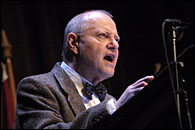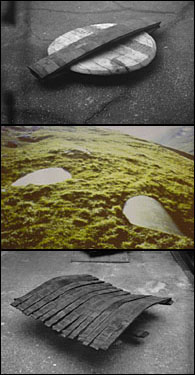Sculpting thought
Royden Rabinowitch's Maxwell Cummings Lecture, presented by the Faculty of Arts on October 17, was a coming-of-age story...with salt licks.
 Sculptor Royden Rabinowitch and a selection of his works below right
Sculptor Royden Rabinowitch and a selection of his works below rightPHOTO: Owen Egan |
|
The celebrated Ontario sculptor, who has pieces in the National Gallery of Canada as well as Montreal's Museum of Fine Arts and the Musée d'art contemporain, began by explaining how a recently rediscovered trove of childhood notes forced him "to clarify the convoluted development" of his artistic impulses.
From as early as he can remember, Rabinowitch recalled an overwhelming urge to order arbitrary "hodgepodges of things." This unscratchable itch, as he termed it, soon revealed itself as a subconscious drive "to deepen, to expand, to refresh the feeling I always got when hearing my father play a movement of a Bach suite on his cello." His family's Richmond Hill home was near a cattle ranch, and by age eight Rabinowitch had discovered the Black Anguses' blue salt licks. The young man was "amazed" at the connection in subjective experience between hearing the changing sounds of his father's cello, and moving around a partially worn salt lick. With the blessing (and financial aid) of his cellist/lawyer father and painter mother, he began secretly replacing the used salt licks with new ones, proudly displaying these treasures on his bedroom shelves.
The structural salt licks led young Rabinowitch to experience a sudden change of heart regarding the monochord, now feeling the musical instrument to be an "impersonal, undeniable, unchanging" order of relations, "indifferent and never to be argued with." Finding himself "completely at a loss" with this new insight, Rabinowitch turned to his mum, who comforted him with heart-to-heart discussions about the historical origins of perspective. For a lad whose favourite possession was a model of the conic sections, this did the trick. Rabinowitch soon immersed himself in classic children's literature: Man Ray's photos of surfaces of mathematical models, Henri Poincaré's Science and Hypothesis, and books about the painter Bruegel. It was a trip to Vienna to see Bruegel's works firsthand which proved "utterly transforming" in striking a "new, shifting precarious equilibrium" in the budding artist, and gave him much to discuss with his pal, Abraham Robinson, the world-renowned University of Toronto mathematician. It was also around this time that the boy really got into the music of Thelonius Monk.
Rabinowitch was 11 years old.
Perhaps it wasn't the most typical childhood.
 |
|
"Looking back, it wasn't so typical," Rabinowitch admitted the day after his lecture. "But there was nothing unusual about it when it's all that one knows."
He confessed to never having "a real connection with my other siblings," none of whom shared his preoccupation for ordering objects (although a brother was fond of dissecting pig hearts). "For some reason," he said, "my mum and dad's interests were mine. People would talk to me about rebelling, but I never did rebel. I had nothing to rebel from."
Now, from the vantage point of reflecting back upon his life and artistic pursuits, Rabinowitch sees his childhood obsessions as a bid to create order within himself.
Popping to his feet and racing to a nearby table, he began fiddling with plastic water bottles. "I'd organize anything," he explained. "Anything, anything, anything. Any thing. You could go like this, and this -- " he quickly assembled the bottles into a cross shape -- "of course, I usually didn't like to have two of the same thing. But anything. Sea shells. A sleeping cat.
"These things built up a feeling in me -- they were ticklish things, maybe because they were too wonderful -- but that became increasingly unsatisfactory. I realize now, but of course I didn't realize then, that I was always trying to get a way to order myself.
"When I was a boy," he continued, "I saw people who went off and had something to do that gave them a certain order, a deep way to coordinate themselves with the world so they're not too isolated but maintain their integrity. But I wasn't able to involve myself in public ordering systems: so if you're not a doctor, if you're not a journalist, what do you do? I didn't have something to do, I didn't have something that ordered me.
"I also knew that satisfying my own order really couldn't be the whole picture, because then it would be a purely self-gratifying thing. But then I became aware that people outside of me -- like Poincaré -- were actually aware of the same struggle that I was aware of, so that my trying to get an order for myself wasn't exactly just personal gratification. There was this situation, that existed quite independent of me, that was involved in this profound dilemma."
As an explanation for how a striking sculpture such as "Medium Grease Cone" ended up in the Art Gallery of Ontario's permanent collection, this all seems far more esoteric than exoteric, but the artist maintains otherwise. "There was no deep thinking," he insists. "It may appear, when I talk about it now, that it somehow had to do with a degree of intense thought. But it doesn't -- I'm just a sculptor.
"I've got a one-track mind, a very narrow type of mind, so I couldn't do anything other than what I did. But now I have, in my own way, a sort of job to do regarding these articulations and surfaces and so on. I'm now closer to those people who have something to do.
"Now I'm not as itchy."

